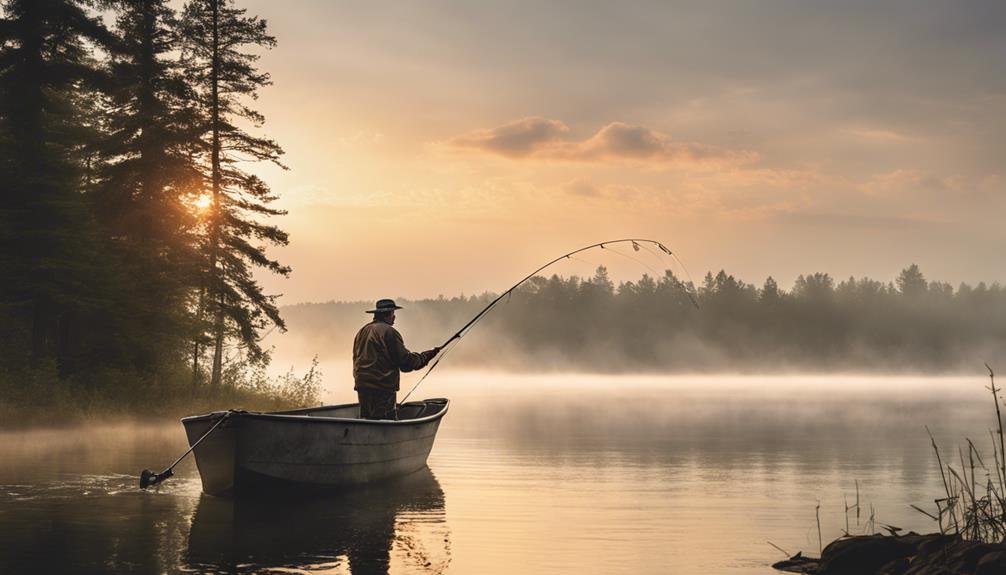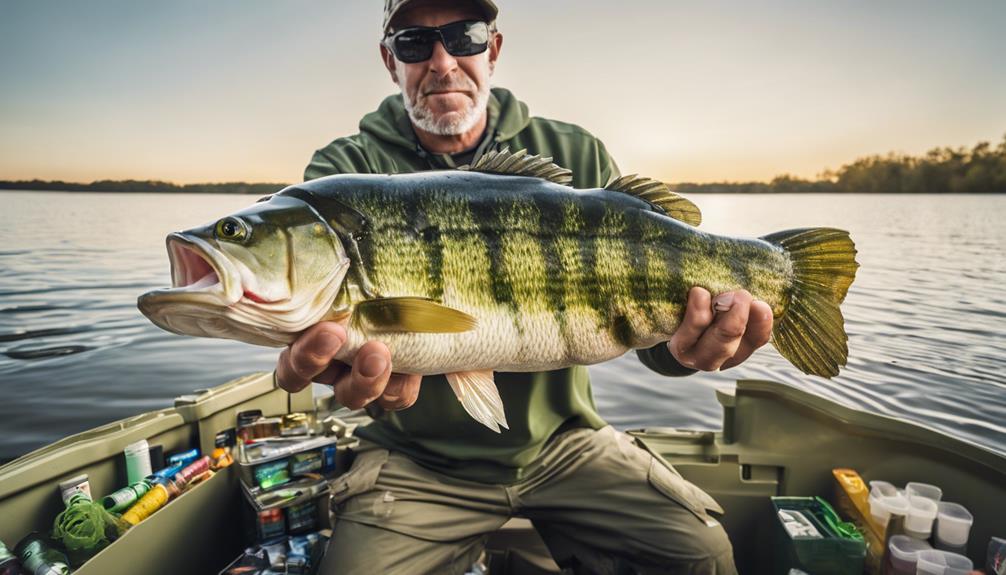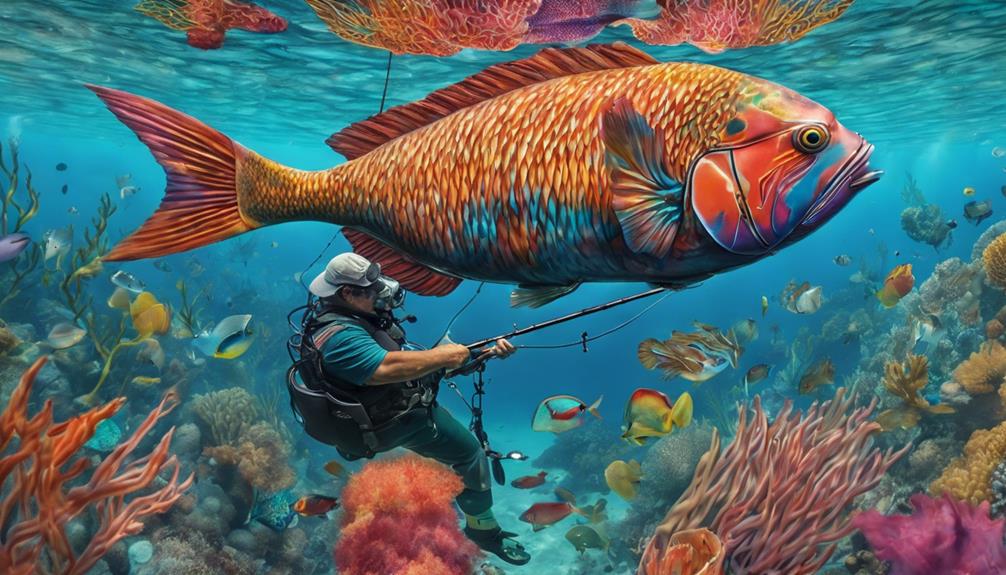Imagine this: you're out on the lake, and you've just landed a massive walleye after hours of patience and skillful technique. The satisfaction of targeting a specific species and finally reeling it in is unmatched.
But why stop there? Species-specific fishing in freshwater offers a whole new level of challenge and excitement that keeps you coming back for more. Each type of fish requires unique strategies and gear, making every catch a learning experience.
So, what makes this approach so rewarding?
Targeting Bass: The Ultimate Guide
Targeting bass in freshwater requires understanding their behavior and habitat preferences to maximize your chances of a successful catch. Largemouth bass, known for their voracious appetites and tendency to inhabit areas with plenty of vegetation, are often found in shallow waters near structures like fallen trees or docks. To lure them in, try using topwater lures early in the morning or late in the evening when they're most active.
Smallmouth bass, on the other hand, prefer clearer and cooler water with rocky structures such as ledges or drop-offs. They tend to feed more actively during the day, so using jigs or crankbaits that mimic their natural prey can be effective.
When targeting largemouth bass, focus on areas with submerged vegetation like lily pads or weed beds. Cast your bait close to these areas and retrieve it slowly to entice the bass. Pay attention to any movement or disturbances in the water, as this could indicate the presence of feeding bass.
For smallmouth bass, look for areas with rocky bottoms and swift currents. Use techniques like drop-shotting or jerkbaits to mimic the movement of small baitfish, which are a staple in the smallmouth bass diet. Remember to adjust your techniques based on the time of day and weather conditions to increase your chances of a successful bass fishing experience.
Crappie Fishing Techniques Uncovered
Unveiling effective techniques for catching crappie in freshwater involves understanding their behavior and preferred habitats. Crappie are known to be structure-oriented fish, often hiding around submerged trees, brush piles, or rocky outcrops. To lure them out, mastering jigging secrets is essential. Crappie are attracted to small, vibrating jigs that mimic the movement of small baitfish. When jigging, try using a light-colored jig on sunny days and a dark-colored one on cloudy days to increase visibility based on light conditions.
Live bait essentials are another crucial aspect of successful crappie fishing. Minnows and small baitfish are highly effective in enticing crappie to bite. When using live bait, make sure to keep it lively and at the depth where the crappie are actively feeding. Adjust the depth of your bait by using a bobber or by counting down after casting to find the right level.
Mastering the Art of Catfishing
To excel in catfishing, understanding the behavior and feeding preferences of these freshwater predators is key. Catfish are known for their keen sense of smell, making bait selection a crucial aspect of your fishing strategy. When it comes to catfishing, consider using strong-smelling baits like chicken liver, stink bait, or even live bait such as worms or minnows to attract these bottom-dwelling creatures effectively.
Here are some essential tips to help you master the art of catfishing:
- Night Fishing: Catfish are more active during the night when they come out to feed in shallower waters. Consider planning your fishing trips during the evening or early morning hours for better chances of a successful catch. Remember to bring along appropriate lighting equipment to enhance visibility in the dark.
- Rod Setup: Opt for a sturdy rod and reel combination capable of handling the weight and power of catfish. Make sure to use a strong fishing line and consider adding a slip sinker rig to prevent the fish from feeling the weight of the sinker when it picks up the bait.
- Casting Techniques: When casting your line, aim for areas with structures like submerged logs, rocks, or brush piles where catfish are likely to hide. Practice accurate casting techniques to place your bait near these structures and entice the catfish to bite. Be patient and allow the catfish enough time to fully take the bait before setting the hook.
Trout Fishing Tips and Tricks
For successful trout fishing, consider adjusting your bait selection based on the specific species of trout in the freshwater area you're targeting. When it comes to trout fishing, understanding the different species such as rainbow, brown, or brook trout is crucial in improving your catch rates.
Fly fishing is a popular technique among trout anglers. Using artificial flies that mimic insects or other natural prey of trout can be highly effective. Different trout species may prefer different types of insects, so it's essential to research the specific species in your fishing area to choose the right fly patterns.
When using artificial lures for trout fishing, opt for ones that resemble small fish, insects, or other prey that trout feed on. Lures that imitate the natural movements and colors of these prey items can attract more bites from trout. Experiment with various sizes, colors, and retrieval speeds to determine what works best for the specific trout species you're targeting.
Catching Walleye Like a Pro
Master the art of catching walleye with expert techniques and proven strategies. When targeting these elusive freshwater predators, understanding walleye hotspots and having the right tackle essentials can significantly increase your chances of a successful fishing trip.
Tips for Catching Walleye Like a Pro:
- Identify Walleye Hotspots: Focus your efforts on areas where walleye are known to thrive. Look for rocky points, submerged islands, weed beds, and areas with structures like fallen trees or underwater boulders. Pay attention to depth changes and water temperature, as walleye are often found in cooler waters.
- Pack the Right Tackle Essentials: Equip yourself with the necessary gear to effectively target walleye. Opt for medium-light to medium-action rods paired with sensitive reels to feel the subtle bites of these cautious fish. Use fluorocarbon line to reduce visibility in the water and choose lures that mimic walleye's favorite prey, such as minnows or leeches.
- Experiment with Different Techniques: Walleye can be picky eaters, so be prepared to adjust your fishing techniques. Try trolling with crankbaits, jigging with live bait, or casting and retrieving soft plastics. Be patient and willing to adapt to the behavior of the walleye in the specific body of water you're fishing.
Secrets to Successful Pike Fishing
When targeting pike, understanding their predatory behavior and preferred habitats is essential for a successful fishing expedition. Pike are apex predators known for their aggressive nature. They often lurk in weed beds, around fallen trees, and near rocky structures, ready to ambush their prey. To lure these cunning predators, selecting the right bait is crucial. Opt for large, flashy lures that mimic the movement of injured fish, as pike are attracted to such easy targets.
Pike behavior plays a significant role in determining your fishing strategy. These fish are known for their explosive strikes, so be prepared for sudden, powerful movements when they bite. When a pike strikes, it often does so with great force, so ensure your gear is sturdy enough to handle their strength. Additionally, pike have sharp teeth, so using a steel leader can prevent them from cutting your line.
Lure selection is key to enticing pike. Choose lures that resemble the fish and prey they usually feed on. Brightly colored spoons, crankbaits, or jerkbaits are popular choices among anglers targeting pike. Vary your retrieval speed and depth to find what triggers a strike from these voracious predators. By understanding pike behavior and selecting the right lures, you can increase your chances of a successful pike fishing adventure.
The Thrill of Landing Muskie

Experiencing the exhilaration of reeling in a massive muskie is a highlight for many freshwater anglers. Landing a trophy muskie can be a true test of your skills and patience, but the feeling of accomplishment is unmatched. Here's why the thrill of landing muskie is so captivating:
- Size Matters: Muskie are known for their impressive size, often referred to as the 'fish of ten thousand casts.' When you finally hook into a trophy muskie, the sheer size and power of these fish make for an intense battle that gets your heart racing. It's a moment you won't soon forget.
- Topwater Action: Muskie are notorious for their explosive topwater strikes. Picture this: you're slowly retrieving your lure across the water's surface, and suddenly, a massive muskie erupts from below, engulfing your bait in a heart-stopping display of power. The adrenaline rush from witnessing such a spectacle is addictive and keeps anglers coming back for more.
- Unpredictability: Muskie fishing is as much about strategy as it's about luck. These apex predators are cunning and unpredictable, requiring you to constantly adapt your techniques. The challenge of outsmarting a wily muskie keeps the excitement levels high throughout your fishing expedition.
Perch Fishing Made Easy
The excitement of muskie fishing can easily transition to the simplicity of perch fishing, where hooking into these smaller yet abundant freshwater species is a rewarding and straightforward endeavor. When it comes to perch fishing, choosing the right bait is crucial. Opt for live bait such as minnows, worms, or insect larvae for the best results. Artificial lures like small jigs or spinners can also be effective in enticing perch to bite.
Exploring perch habitats is key to a successful fishing trip. Look for these fish near underwater structures like rocks, fallen trees, or weed beds where they seek shelter and food. During different seasons, perch exhibit varying patterns. In the spring, they tend to move to shallower waters for spawning, making it an ideal time for anglers to target them. As summer progresses, perch often move to deeper, cooler waters, requiring a shift in fishing tactics.
To increase your chances of a good catch, consider employing effective techniques such as drop-shotting or using a bobber to suspend your bait at the desired depth. Patience is a virtue in perch fishing, as these fish can sometimes be picky eaters. By adapting to their habitat and behavior, you can make perch fishing not only easy but also highly rewarding.
Frequently Asked Questions
What Are the Best Types of Bait to Use for Targeting Multiple Species of Freshwater Fish?
When targeting multiple species of freshwater fish, your best bet for bait selection is to go with versatile options that appeal to a wide range of fish. Utilize baits like worms, minnows, or artificial lures that mimic common prey items found in the water.
How Can I Locate the Best Fishing Spots for Different Freshwater Species?
To find the best fishing spots for different freshwater species, study species behavior and habitats. Explore various fishing hotspots using suitable techniques. Look for signs like feeding activity, underwater structures, and vegetation.
Trout prefer cool, oxygen-rich water near rocks, while bass like cover and ambush points. Crappie often hang out near submerged trees. Understanding these preferences will help you locate the ideal spots for each species.
Are There Any Special Techniques for Fishing During Different Seasons of the Year?
During winter, focus on ice fishing in freshwater, targeting species like trout and walleye in colder waters.
In spring, adjust your approach to capitalize on spawning patterns of various fish species. Experiment with different lures and baits to match the seasonal preferences of the fish.
How Can I Properly Handle and Release Fish to Ensure Their Survival After Being Caught?
When catching fish, proper handling and release are crucial for their survival. Techniques like using barbless hooks, keeping the fish in the water as much as possible, and avoiding touching their gills help ensure they can swim away healthy.
This approach promotes conservation and ethical fishing practices. By taking care of the fish you catch, you contribute to the overall health of the freshwater ecosystem.
What Are Some Common Mistakes to Avoid When Targeting Specific Species of Freshwater Fish?
To target specific freshwater fish, avoid the mistake of using the wrong gear. Make sure you have the proper equipment for each species.
Patience and practice are key. Learn the behavior and preferences of the fish you're targeting. Avoid rushing the process.
Conclusion
So why choose species-specific fishing in freshwater?
By targeting specific fish like bass, crappie, catfish, trout, walleye, pike, muskie, and perch, you can hone your skills, learn specialized techniques, and increase your chances of a successful catch.
Each species offers its own unique challenges and rewards, making fishing more exciting and fulfilling.
So next time you head out to the water, consider focusing on a specific species for a more enjoyable and productive fishing experience.



